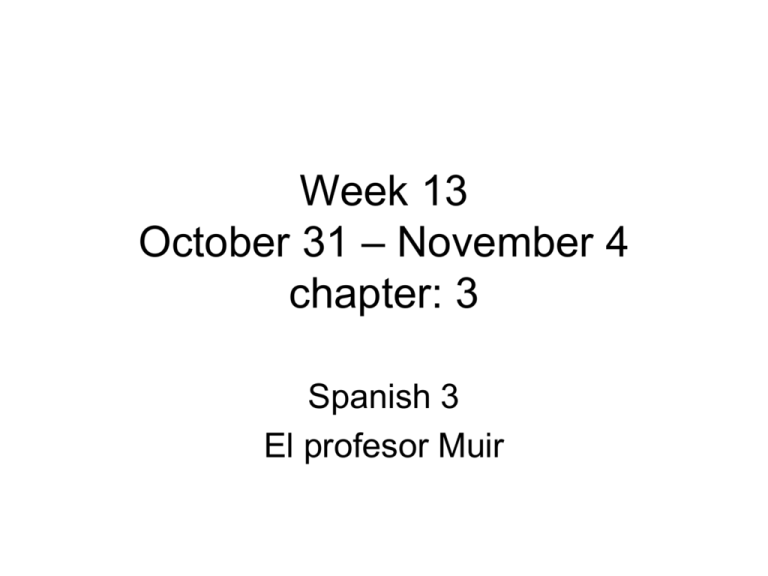
Week 13
October 31 – November 4
chapter: 3
Spanish 3
El profesor Muir
noviembre de 2011
el domingo
el lunes
el martes
el miércoles
el jueves
el viernes
el sábado
1
Ch. 3 Project
Outline Due
2
Formal
Command
Quiz Ch. 3
3
4
@ Lab A201
Subjunctive
Quiz Ch. 3
5
6
WEEK 14
7
@ Lab A16
8
Ch. 3 Project
Due
9
10
11
Ch. 3 Exam
12
13
WEEK 15
14
@ Lab A16
Ch. 4 Vocab
15
16
Wordchamp
4A Due
17
Vocab 4A
Quiz
18
@ Lab A201
19
20
WEEK 16
21
No School
22
No School
23
No School
24
No School
25
No School
26
27
WEEK 17
28
Wordchamp
4B Due
29
Vocab 4B
Quiz
30
Performance
Writing Exam
diciembre de 2011
el domingo
el lunes
el martes
el miércoles
el jueves
el viernes
el sábado
1
2
3
4
WEEK 18
5
@ Lab A16:
Performance
Speaking
Exam
6
7
Grammar
Quiz Ch. 4
8
9
@ Lab A201
10
11
12
13
Final Exams:
1st
14
Final Exams
15
Final Exams
16
Final Exams
17
18
19
No School
20
No School
21
No School
22
No School
23
No School
24
25
26
No School
27
No School
28
No School
29
No School
30
No School
31
WEEK AT A GLANCE
Day
Activity
Monday
• @ Lab A 16 / Familiar Commands Quiz
Tuesday
• Ch. 3 Project Outline Due
Wednesday • Formal Command Quiz
Thursday
Friday
• Review
• Subjunctive Quiz
El lunes (31 de octubre)
Mins Activity
5
8
Attendance / Word of the Day
Quiz: familiar commands
8
8
8
8
3
5
Formal commands (usted y ustedes)
Culture: el día de las brujas
Comparing 2 Holidays (WK)
Speaking: CNN interview (if time)
Reminders/Announcements:
Summarize
53
total
TAREA: (1) Follow up from CNN interview
Quiz: familiar commands
• Give the affirmative tú
• Give the negative tú
1.
2.
3.
4.
5.
6. No escribir
7. No poner
8. No decir
9. No comer
10. No levantarse
tomar
Salir
Decir
hacer
levantarse
Formal Commands
• Formal commands are used with people you
address as usted or ustedes.
Formal Commands
Copyright © 2008 Vista Higher Learning. All rights reserved.
12.2-9
The usted and ustedes commands, like the
negative tú commands, are formed by
dropping the final -o of the yo form of the
present tense. For -ar verbs, add -e or -en.
For -er and -ir verbs, add -a or -an.
Copyright © 2008 Vista Higher Learning. All rights reserved.
12.2-10
Verbs with irregular yo forms maintain the
same irregularity in their formal commands.
These verbs include conducir, conocer,
decir, hacer, ofrecer, oír, poner, salir,
tener, traducir, traer, venir, and ver.
Copyright © 2008 Vista Higher Learning. All rights reserved.
12.2-11
Note also that verbs maintain their stem
changes in usted and ustedes commands.
Copyright © 2008 Vista Higher Learning. All rights reserved.
12.2-12
Verbs ending in -car, -gar, and -zar have a
spelling change in the command forms.
Copyright © 2008 Vista Higher Learning. All rights reserved.
12.2-13
These verbs have irregular formal commands.
Copyright © 2008 Vista Higher Learning. All rights reserved.
12.2-14
To make a formal command negative, simply
place no before the verb.
Copyright © 2008 Vista Higher Learning. All rights reserved.
12.2-15
In affirmative commands, reflexive, indirect
and direct object pronouns are always
attached to the end of the verb.
Copyright © 2008 Vista Higher Learning. All rights reserved.
12.2-16
¡Atención! When a pronoun is attached to an
affirmative command that has two or more
syllables, an accent mark is added to
maintain the original stress.
Copyright © 2008 Vista Higher Learning. All rights reserved.
12.2-17
In negative commands, these pronouns
always precede the verb.
Copyright © 2008 Vista Higher Learning. All rights reserved.
12.2-18
Usted and ustedes can be used with the
command forms to strike a more formal
tone. In such instances they follow the
command form.
Copyright © 2008 Vista Higher Learning. All rights reserved.
12.2-19
Indica los mandatos (commands) afirmativos y
negativos correspondientes.
1. escucharlo (Ud.)
Escúchelo
_____________.
No lo escuche
_____________.
2. decírmelo (Uds.)
_____________.
_____________.
3. salir (Ud.)
_____________.
_____________.
4. servírnoslo (Uds.)
_____________.
_____________.
5. barrerla (Ud.)
_____________.
_____________.
6. hacerlo (Ud.)
_____________.
_____________.
Copyright © 2008 Vista Higher Learning. All rights reserved.
12.2-20
¡El día de las brujas!
¡El día de las brujas!
• Dulces = candy
• Disfraz = costume
• Peluca = wig
• Accesorios = accesories
¡El día de las brujas!
• (1) ¿Es el día de las brujas tu día
festivo favorito?
• (2) ¿Cuándo eras tú niño(a), te
gustaba el día de las brujas?
• (3) ¿De niño(a), te disfrazabas
para el día de las brujas?
• (4) ¿Qué vas a hacer esta
noche?
El Día de los Muertos
Day of the Dead
The path to the living shall not be
made slippery by tears
This image makes me think of…..
How do people view death in Latin countries?
• Death is not to be feared
• Death is just another part of
living
• Although the living body dies,
the soul continues to live on
• Life is cyclical
• Respect and honor “los
difuntos”
The Days of the Celebration
•
•
•
•
October 30-31st - Build the altars in the home
November 1st – Día de los Angelitos
November 2nd - Día de los muertos
November 2nd – In the evening, collect the food and
offerings left on the altar and leave a trail of cempasuchil
that leads back to the panteón. The souls follow the scent
of the flower to the panteón where they spend the evening
with loved ones before they return to “home”. Family
members burn candles on the cripta and place a flower
arco while spending the evening with others who want to
remember the deceased.
Day of the Dead Altars
• Usually Includes three tiers or levels
• Must have a picture of the deceased
person included that you wish to honor
• Usually has cempasuchil, the traditional
flower of the dead (orange marigold)
• Usually has papel picado – purple-pain,
white-hope, pink-celebration
• Usually has water and food-pan de los
muertos
• Cavaleras - Candy skulls – three small,
one large
• Velas – to light the way home
• Ofrendas – offerings to entice the dead
Selling the cempasuchil flowers – the
yellow marigold that entice the dead
through their fragrant scent.
A festival to celebrate the holiday.
Death is not to be feared – it is a
necessary part of living.
More of the celebration……
A flower Vendor
On the grave…..
A day in the Panteón
A moment of reflection….
El arco de cempasuchil
Las Calaveras
A traditional altar in a Mexican home
A gravesite,
with the
marigold
flower
Pan de los Muertos
• A sweet bread that is made for the dead and
placed on the altar
• After the long journey, the dead are tired and
crave sweets to gain energy
• It is usually made in the shape of a
person/ghost, or circular with knots and
ropes
Pan de los Muertos
HAS YOUR OPINION OF DEATH CHANGED?
How do you feel about death? Do you believe that the souls of
the deceased can come back to visit you? Would you like to
spend the day with a loved one that has passed on? Why or why
not?
Vamos a comparar
Legend has it that if you take something from
the ofrenda, a ghost will come in the middle
of the night and pull your toes!
• Vas a imaginar que eres reportero para CNN.
Debes entrevistar a 2 compañeros de clase.
Debes
• pedir a los compañeros que digan las 3 causas
más grandes de estrés en sus vidas
Connector Words
•
•
•
•
•
•
•
En mi opinión
Primero
Luego
en contraste
Desafortunadamente
Además
por un lado…por el otro
lado
•
•
•
•
•
•
•
•
para empezar
en primer lugar
en cambio
por lo contrario
de todos lodos
en conclusión
ya que
por lo tanto
LA TAREA
• escoger una de las 3 causas que han
mencionado y descrbir cómo esta causa
impacta a otras personas
• dar una recomendación diferente para
controlar estrés






